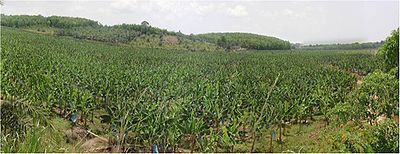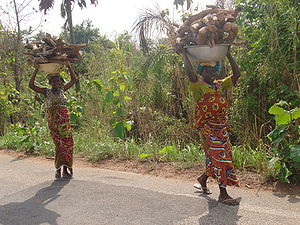
Agriculture in Côte d'Ivoire
Encyclopedia

Agriculture
Agriculture is the cultivation of animals, plants, fungi and other life forms for food, fiber, and other products used to sustain life. Agriculture was the key implement in the rise of sedentary human civilization, whereby farming of domesticated species created food surpluses that nurtured the...
was the foundation of the economy in Côte d'Ivoire
Côte d'Ivoire
The Republic of Côte d'Ivoire or Ivory Coast is a country in West Africa. It has an area of , and borders the countries Liberia, Guinea, Mali, Burkina Faso and Ghana; its southern boundary is along the Gulf of Guinea. The country's population was 15,366,672 in 1998 and was estimated to be...
and its main source of growth. In 1987 the agricultural sector contributed 35 percent of the country's GDP and 66 percent of its export revenues, provided employment for about two-thirds of the national work force, and generated substantial revenues despite the drop in coffee and cocoa prices. From 1965 to 1980, agricultural GDP grew by an average 4.6 percent per year. Growth of agricultural GDP from coffee
Coffee
Coffee is a brewed beverage with a dark,init brooo acidic flavor prepared from the roasted seeds of the coffee plant, colloquially called coffee beans. The beans are found in coffee cherries, which grow on trees cultivated in over 70 countries, primarily in equatorial Latin America, Southeast Asia,...
, cocoa, and timber
Timber
Timber may refer to:* Timber, a term common in the United Kingdom and Australia for wood materials * Timber, Oregon, an unincorporated community in the U.S...
production, which totaled nearly 50 percent of Côte d'Ivoire's export revenues, averaged 7 percent a year from 1965 to 1980.
Contributing to this impressive performance were an abundance of fertile land, cheap labor, the collective efforts of many farmers cultivating small plots, relatively favorable commodity prices, and a stable political environment.
Success in the 1960s and 1970s overshadowed major problems developing in the agricultural sector. By the late 1980s, despite efforts to diversify its crops, 55 percent of Côte d'Ivoire's export earnings still came from cocoa and coffee
Coffee
Coffee is a brewed beverage with a dark,init brooo acidic flavor prepared from the roasted seeds of the coffee plant, colloquially called coffee beans. The beans are found in coffee cherries, which grow on trees cultivated in over 70 countries, primarily in equatorial Latin America, Southeast Asia,...
. Moreover, highly volatile world markets for both commodities caused sharp fluctuations in government revenues and made development planning difficult. In addition, Côte d'Ivoire was not yet self-sufficient in food production and imported substantial quantities of rice, wheat, fish, and red meat. Finally, despite an enormous increase in the volume of agricultural output since independence, there was little improvement in agricultural productivity. To achieve higher production figures, traditional farmers using traditional technologies simply cleared more and more land.

Agricultural diversification
In the agricultural context, diversification can be regarded as the re-allocation of some of a farm's productive resources, such as land, capital, farm equipment and paid labour, into new activities...
and regional development projects with the hope of boosting agricultural production by 4 percent per year. The plan, estimated to cost CFA F100 billion per annum (with just over 50 percent coming from foreign lenders) would allow the country to become self-sufficient in food (with the exception of wheat
Wheat
Wheat is a cereal grain, originally from the Levant region of the Near East, but now cultivated worldwide. In 2007 world production of wheat was 607 million tons, making it the third most-produced cereal after maize and rice...
) and expand the production of rubber
Rubber
Natural rubber, also called India rubber or caoutchouc, is an elastomer that was originally derived from latex, a milky colloid produced by some plants. The plants would be ‘tapped’, that is, an incision made into the bark of the tree and the sticky, milk colored latex sap collected and refined...
, cotton
Cotton
Cotton is a soft, fluffy staple fiber that grows in a boll, or protective capsule, around the seeds of cotton plants of the genus Gossypium. The fiber is almost pure cellulose. The botanical purpose of cotton fiber is to aid in seed dispersal....
, sugar
Sugar
Sugar is a class of edible crystalline carbohydrates, mainly sucrose, lactose, and fructose, characterized by a sweet flavor.Sucrose in its refined form primarily comes from sugar cane and sugar beet...
, bananas, pineapple
Pineapple
Pineapple is the common name for a tropical plant and its edible fruit, which is actually a multiple fruit consisting of coalesced berries. It was given the name pineapple due to its resemblance to a pine cone. The pineapple is by far the most economically important plant in the Bromeliaceae...
s, and tropical oils.
In spite of these efforts, the agricultural sector appeared unable to adapt to changing conditions. Distortions in the system of incentives reduced the comparative advantage of alternative crops. The vast revenues collected by the CSSPPA were often spent on marginally profitable investments, like the costly sugar complexes or expensive land clearing programs. Finally, some diversification
Diversification
Diversification may refer to:* Diversification involves spreading investments* Diversification is a corporate strategy to increase market penetration...
crops, like coconut and palm oil
Palm oil
Palm oil, coconut oil and palm kernel oil are edible plant oils derived from the fruits of palm trees. Palm oil is extracted from the pulp of the fruit of the oil palm Elaeis guineensis; palm kernel oil is derived from the kernel of the oil palm and coconut oil is derived from the kernel of the...
, faced new threats as health-conscious consumers in the United States and Europe began turning away from tropical oils. Consequently, the future for Ivoirian agriculture was uncertain.
External links
- West African Agricultural Market Observer/Observatoire du Marché Agricole (RESIMAO), a project of the West-African Market Information Network (WAMIS-NET), provides live market and commodity prices from fifty seven regional and local public agricultural markets across Benin, Burkina Faso, Côte d'Ivoire, Guinea, Niger, Mali, Senegal, Togo, and Nigeria. Sixty commodities are tracked weekly. The project is run by the Benin Ministry of Agriculture, and a number of European, African, and United Nations agencies.

